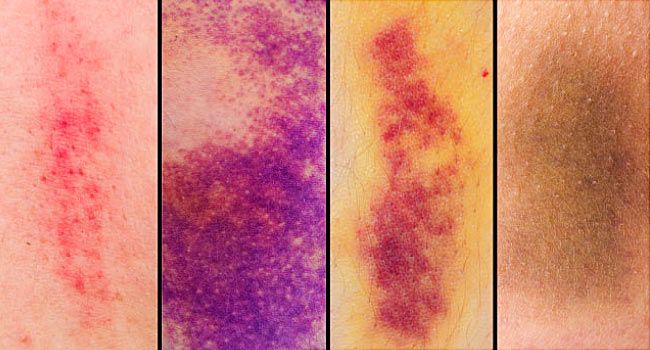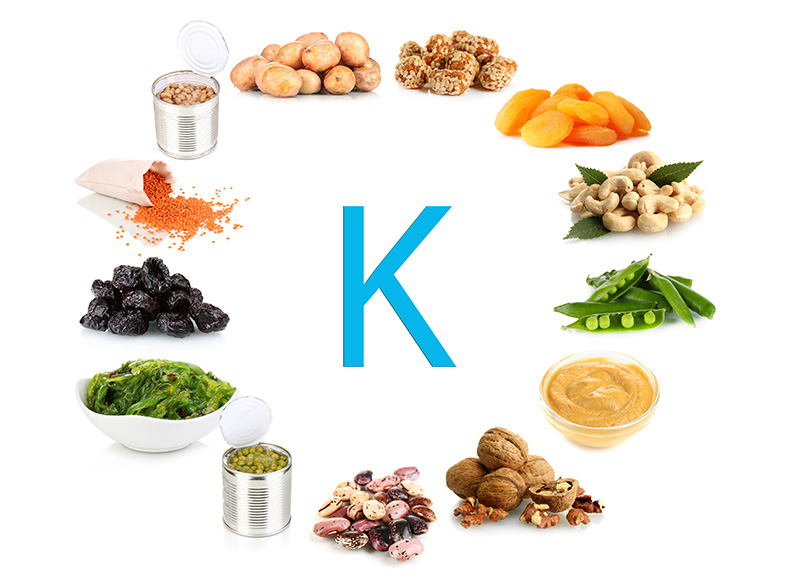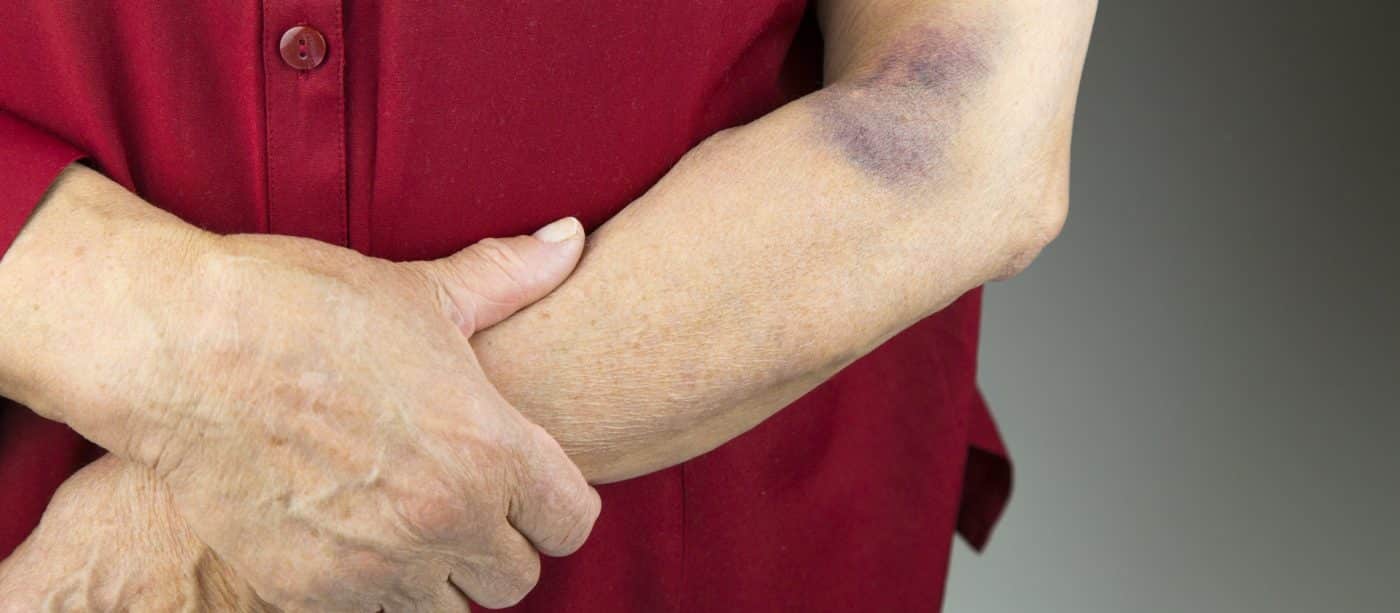Sometimes you may suddenly notice some kind of bruise on your body and you may be clueless as to how it happened?
It might even scare you if the cause is unknown.
So, what are these bruises and how do they appear out of nowhere?
Bruises are a general skin injury. It is the result of blood vessels transporting blood back and forth between the heart, other tissues and organs of the human body that are shattered due to some injury or weakness.
This state frequently disappears after a few weeks, but you should not hurry because it may be confused with signs and symptoms of dangerous conditions.
 A bruise is generally recognised as a skin color change, due to the breaking of small blood vessels under the skin surface and cause bleeding after an injury.
Blood from the affected lesions will be concentrated near the skin layer and we will see a dark blue patch.
This is because all the red blood cells and blood elements cause discoloration of the skin.
A bruise is generally recognised as a skin color change, due to the breaking of small blood vessels under the skin surface and cause bleeding after an injury.
Blood from the affected lesions will be concentrated near the skin layer and we will see a dark blue patch.
This is because all the red blood cells and blood elements cause discoloration of the skin.
 Bruises are commonly red or purple discolorations right after an injury appeared.
This is because they are the color of the blood that has combined underneath the skin.
As a bruise cures, the human body breaks down blood and fluids that have accumulated under the skin. As this happens the bruise turns into different types of colors.
Within the first some days after getting a bruise, the area may become a black mark, blue mark, or else purple blemish.
Within 5 to 10 days after appearing a bruise, the surface may turn greenish or yellowish.
During the final section of healing, approximately 10 to 14 days after getting a bruise, the area will usually be brown in color.
As healing progresses, the area will become lighter and lighter until it eventually fades away entirely.
How long do bruises last? Most heal completely within about 2 weeks.
Bruises are commonly red or purple discolorations right after an injury appeared.
This is because they are the color of the blood that has combined underneath the skin.
As a bruise cures, the human body breaks down blood and fluids that have accumulated under the skin. As this happens the bruise turns into different types of colors.
Within the first some days after getting a bruise, the area may become a black mark, blue mark, or else purple blemish.
Within 5 to 10 days after appearing a bruise, the surface may turn greenish or yellowish.
During the final section of healing, approximately 10 to 14 days after getting a bruise, the area will usually be brown in color.
As healing progresses, the area will become lighter and lighter until it eventually fades away entirely.
How long do bruises last? Most heal completely within about 2 weeks.
 Applying an ice pack on to the skin directly after the injury is a surefire way to restrict the size and blackness of the bruise.
Ice acts by causing vasoconstriction – or narrowing of the blood vessels – to decrease the amount of blood that gets trapped below the skin surface.
While you should use ice therapy immediately after an impact, you can also apply it systematically throughout the day.
Keep the pack on the skin for up to twenty minutes at a time, as frequently as you like.
For even better results, elevate the injured area during and after icing.
Applying an ice pack on to the skin directly after the injury is a surefire way to restrict the size and blackness of the bruise.
Ice acts by causing vasoconstriction – or narrowing of the blood vessels – to decrease the amount of blood that gets trapped below the skin surface.
While you should use ice therapy immediately after an impact, you can also apply it systematically throughout the day.
Keep the pack on the skin for up to twenty minutes at a time, as frequently as you like.
For even better results, elevate the injured area during and after icing.
 To limit the blood flow, wrap the injured body part with a condensation bandage. If you haven’t got a condensation bandage to hand, try pushing down lightly on the skin for many minutes after the injury.
Compression won’t just decrease the bruising, it will also relieve some of your pain and also swelling.
To limit the blood flow, wrap the injured body part with a condensation bandage. If you haven’t got a condensation bandage to hand, try pushing down lightly on the skin for many minutes after the injury.
Compression won’t just decrease the bruising, it will also relieve some of your pain and also swelling.
 Prevent vitamin D lacking and heal your bruises at the same time by going outdoors.
Ultraviolet rays in the sunlight can aid to break down bilirubin, a pigment in the blood that generally causes the yellow color of a bruise.
Expose the bruised area to sunlight for fifteen to 20 minutes a day. You should see a remarkable difference after just a couple of bruise treatments.
If you want to stay at outdoors for longer than this, be sure to use an all-natural sunscreen to maintain your skin safe and wrinkle-free.
Prevent vitamin D lacking and heal your bruises at the same time by going outdoors.
Ultraviolet rays in the sunlight can aid to break down bilirubin, a pigment in the blood that generally causes the yellow color of a bruise.
Expose the bruised area to sunlight for fifteen to 20 minutes a day. You should see a remarkable difference after just a couple of bruise treatments.
If you want to stay at outdoors for longer than this, be sure to use an all-natural sunscreen to maintain your skin safe and wrinkle-free.
 For healthy skin, bones, and also blood, vitamin K is a must. While it’s imperative that we get vitamin K from our diets (from foods like leafy greens, cruciferous vegetables, and fermented soy), we require a stronger concentration when trying to heal bruises.
Few research registers that topically applied vitamin K reduces bruising following cosmetic procedures.
To use this treatment, gently rub vitamin K cream into the wound two to three times daily.
For healthy skin, bones, and also blood, vitamin K is a must. While it’s imperative that we get vitamin K from our diets (from foods like leafy greens, cruciferous vegetables, and fermented soy), we require a stronger concentration when trying to heal bruises.
Few research registers that topically applied vitamin K reduces bruising following cosmetic procedures.
To use this treatment, gently rub vitamin K cream into the wound two to three times daily.
Know About Bruises
Are you disturbed about bruises? Are you worried about how to avoid or treat bruises? Don’t worry, the below information will help you. These measures are very simple, easy and effective. They can be done right at your place. However, before that, let’s know some essential information about this issue to get the best view on it and also aid you discover the condition of your bruises to have the most appropriate treatment.What Is A Bruise ? And Define Bruise
 A bruise is generally recognised as a skin color change, due to the breaking of small blood vessels under the skin surface and cause bleeding after an injury.
Blood from the affected lesions will be concentrated near the skin layer and we will see a dark blue patch.
This is because all the red blood cells and blood elements cause discoloration of the skin.
A bruise is generally recognised as a skin color change, due to the breaking of small blood vessels under the skin surface and cause bleeding after an injury.
Blood from the affected lesions will be concentrated near the skin layer and we will see a dark blue patch.
This is because all the red blood cells and blood elements cause discoloration of the skin.
What Are The Different Types of Bruises?
There are many different types of bruises. A bruise that has bleeding from broken blood vessels leaking into the upper layers of skin is known as an ecchymosis. An instance example of this type of bruise is a shiner or black eye. Hematomas are also bruises that develop when blood clots and makes a lump underneath the surface of the skin. The damaged section may be raised, swollen, and painful. A “goose egg” appears on the forehead is an example of this kind of bruise. Children frequently get these types of injuries. The scalp consists a lot of blood vessels so an injury to the head may cause this type of bruise.What Do the Various Colors of Bruises Mean As?
 Bruises are commonly red or purple discolorations right after an injury appeared.
This is because they are the color of the blood that has combined underneath the skin.
As a bruise cures, the human body breaks down blood and fluids that have accumulated under the skin. As this happens the bruise turns into different types of colors.
Within the first some days after getting a bruise, the area may become a black mark, blue mark, or else purple blemish.
Within 5 to 10 days after appearing a bruise, the surface may turn greenish or yellowish.
During the final section of healing, approximately 10 to 14 days after getting a bruise, the area will usually be brown in color.
As healing progresses, the area will become lighter and lighter until it eventually fades away entirely.
How long do bruises last? Most heal completely within about 2 weeks.
Bruises are commonly red or purple discolorations right after an injury appeared.
This is because they are the color of the blood that has combined underneath the skin.
As a bruise cures, the human body breaks down blood and fluids that have accumulated under the skin. As this happens the bruise turns into different types of colors.
Within the first some days after getting a bruise, the area may become a black mark, blue mark, or else purple blemish.
Within 5 to 10 days after appearing a bruise, the surface may turn greenish or yellowish.
During the final section of healing, approximately 10 to 14 days after getting a bruise, the area will usually be brown in color.
As healing progresses, the area will become lighter and lighter until it eventually fades away entirely.
How long do bruises last? Most heal completely within about 2 weeks.
What Are The Common Symptoms Of Bruises?
Common symptoms of bruises consider: At first, a new instant bruise may be reddish, then dark blue or violet within a some hours and will become yellow or green after some days of bruising. Bruises are generally sensitive and sometimes even painful and irritating in the first few days, but the pain generally goes away when the bruise goes off. Because the skin is not harmful by the bruise, so there is no risk of infection.Who Is At Risk Of Bruises?
Bruising is a very usual condition that can affect at any age but is mostly seen in older people and people with blood diseases. Especially those with blood diseases are often at a high risk for bruising.1. Ice
 Applying an ice pack on to the skin directly after the injury is a surefire way to restrict the size and blackness of the bruise.
Ice acts by causing vasoconstriction – or narrowing of the blood vessels – to decrease the amount of blood that gets trapped below the skin surface.
While you should use ice therapy immediately after an impact, you can also apply it systematically throughout the day.
Keep the pack on the skin for up to twenty minutes at a time, as frequently as you like.
For even better results, elevate the injured area during and after icing.
Applying an ice pack on to the skin directly after the injury is a surefire way to restrict the size and blackness of the bruise.
Ice acts by causing vasoconstriction – or narrowing of the blood vessels – to decrease the amount of blood that gets trapped below the skin surface.
While you should use ice therapy immediately after an impact, you can also apply it systematically throughout the day.
Keep the pack on the skin for up to twenty minutes at a time, as frequently as you like.
For even better results, elevate the injured area during and after icing.
2. Compression
 To limit the blood flow, wrap the injured body part with a condensation bandage. If you haven’t got a condensation bandage to hand, try pushing down lightly on the skin for many minutes after the injury.
Compression won’t just decrease the bruising, it will also relieve some of your pain and also swelling.
To limit the blood flow, wrap the injured body part with a condensation bandage. If you haven’t got a condensation bandage to hand, try pushing down lightly on the skin for many minutes after the injury.
Compression won’t just decrease the bruising, it will also relieve some of your pain and also swelling.
3. Sunlight
 Prevent vitamin D lacking and heal your bruises at the same time by going outdoors.
Ultraviolet rays in the sunlight can aid to break down bilirubin, a pigment in the blood that generally causes the yellow color of a bruise.
Expose the bruised area to sunlight for fifteen to 20 minutes a day. You should see a remarkable difference after just a couple of bruise treatments.
If you want to stay at outdoors for longer than this, be sure to use an all-natural sunscreen to maintain your skin safe and wrinkle-free.
Prevent vitamin D lacking and heal your bruises at the same time by going outdoors.
Ultraviolet rays in the sunlight can aid to break down bilirubin, a pigment in the blood that generally causes the yellow color of a bruise.
Expose the bruised area to sunlight for fifteen to 20 minutes a day. You should see a remarkable difference after just a couple of bruise treatments.
If you want to stay at outdoors for longer than this, be sure to use an all-natural sunscreen to maintain your skin safe and wrinkle-free.
4. Vitamin K
 For healthy skin, bones, and also blood, vitamin K is a must. While it’s imperative that we get vitamin K from our diets (from foods like leafy greens, cruciferous vegetables, and fermented soy), we require a stronger concentration when trying to heal bruises.
Few research registers that topically applied vitamin K reduces bruising following cosmetic procedures.
To use this treatment, gently rub vitamin K cream into the wound two to three times daily.
For healthy skin, bones, and also blood, vitamin K is a must. While it’s imperative that we get vitamin K from our diets (from foods like leafy greens, cruciferous vegetables, and fermented soy), we require a stronger concentration when trying to heal bruises.
Few research registers that topically applied vitamin K reduces bruising following cosmetic procedures.
To use this treatment, gently rub vitamin K cream into the wound two to three times daily.
5. Aloe Vera
The aloe plant has been prized since centuries thanks to its healing powers. It not only relieves pain and swelling, but it decreases the appearance of bruises too. Shortly after the injury, apply one teaspoon of aloe vera gel to the affected area and smoothly massage it into the skin. Renew this treatment several times daily until the bruise is gone. If you’re buying a ready-made aloe product, check that it doesn’t contain unpleasant additives. For a truly natural aloe product, including growing your own plant and harvesting its gel as you require it. You can learn more about harvesting and utilizing aloe vera here.6. Vitamin C
Vitamin C is large number of antioxidant and as well as excellent anti-inflammatory properties. When consumed or applied topically, it promotes the healing of bruises and other types of wounds. Consume vitamin C in the form of capsules, and get it from fresh fruits and vegetables, or apply it straightly to the skin surface. This DIY regenerating vitamin C home serum will get rid of your bruises and aid you looking younger!7. Pineapple And Papaya
These tropical and natural fruits are not only rich in vitamin C, but they also consist an enzyme-based substance known as bromelain. Bromelain decreases swelling and also inflammation and breaks down blood clots, which is why it’s such a great treatment for bruises. One study recommends that taking bromelain orally improves pain and swelling after tooth extractions. It’s unlikely that you’ll get sufficient bromelain from eating pineapple (especially as most of the substance is found in the fruit’s hard core) but you can take bromelain in the form of supplements or apply it topically. Some people even suggested blending the fruit into a pulp and applying it directly to the skin. However, it is best not to use this pulp on broken skin as it could sting!8. Essential Oils
Large number of essential oils can decrease the pain, swelling, and appearance of your bruises. Don’t forget that you must mix essential oils with a suitable carrier oil when applying topically. Some of the best include:- Frankincense Essential Oil
- Rosemary Essential Oil
- Lavender Essential Oil
- Cypress Essential Oil
- Geranium Essential Oil
- Lemongrass Essential Oil.
When To Consult A Doctor?
You should consult a doctor if you have the following signs and symptoms:- Bruising when consuming aspirin or other anticoagulants.
- Swelling and pain in the injured area.
- Bruising occurs after a sharp collision or falls.
- Bruising happens along with fractures.
- Bruising does not enhance within two weeks or does not improve completely after three or four weeks.
- Bruise under the nail and reason for pain.
- Bruising with bleeding gums, nose or mouth.
- Bruising with blood in urine, feces, and eyes.
- Bruise for unknown reasons, usually periodic.


